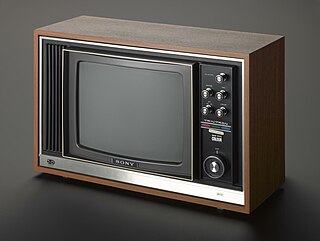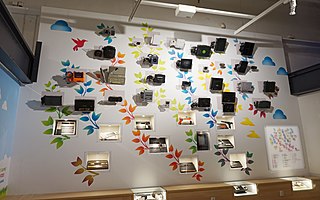Related Research Articles

Chrominance is the signal used in video systems to convey the color information of the picture, separately from the accompanying luma signal. Chrominance is usually represented as two color-difference components: U = B′ − Y′ (blue − luma) and V = R′ − Y′ (red − luma). Each of these different components may have scale factors and offsets applied to it, as specified by the applicable video standard.

Digital video is an electronic representation of moving visual images (video) in the form of encoded digital data. This is in contrast to analog video, which represents moving visual images in the form of analog signals. Digital video comprises a series of digital images displayed in rapid succession, usually at 24, 30, or 60 frames per second. Digital video has many advantages such as easy copying, multicasting, sharing and storage.

A motherboard is the main printed circuit board (PCB) in general-purpose computers and other expandable systems. It holds and allows communication between many of the crucial electronic components of a system, such as the central processing unit (CPU) and memory, and provides connectors for other peripherals. Unlike a backplane, a motherboard usually contains significant sub-systems, such as the central processor, the chipset's input/output and memory controllers, interface connectors, and other components integrated for general use.

Sony Group Corporation, formerly known as Tokyo Tsushin Kogyo K.K. and Sony Corporation (ソニー株式会社), is a Japanese multinational conglomerate corporation headquartered in Minato, Tokyo, Japan. The Sony Group comprises entities such as Sony Corporation, Sony Semiconductor Solutions, Sony Entertainment, Sony Interactive Entertainment, Sony Financial Group, and others.

Video is an electronic medium for the recording, copying, playback, broadcasting, and display of moving visual media. Video was first developed for mechanical television systems, which were quickly replaced by cathode-ray tube (CRT) systems which, in turn, were replaced by flat panel displays of several types.

A video game console is an electronic device that outputs a video signal or image to display a video game that can be played with a game controller. These may be home consoles, which are generally placed in a permanent location connected to a television or other display devices and controlled with a separate game controller, or handheld consoles, which include their own display unit and controller functions built into the unit and which can be played anywhere. Hybrid consoles combine elements of both home and handheld consoles.

Videotape is magnetic tape used for storing video and usually sound in addition. Information stored can be in the form of either an analog or digital signal. Videotape is used in both video tape recorders (VTRs) and, more commonly, videocassette recorders (VCRs) and camcorders. Videotapes have also been used for storing scientific or medical data, such as the data produced by an electrocardiogram.
A DVD player is a device that plays DVDs produced under both the DVD-Video and DVD-Audio technical standards, two different and incompatible standards. Some DVD players will also play audio CDs. DVD players are connected to a television to watch the DVD content, which could be a movie, a recorded TV show, or other content.

Trinitron was Sony's brand name for its line of aperture-grille-based CRTs used in television sets and computer monitors, one of the first television systems to enter the market since the 1950s. Constant improvement in the basic technology and attention to overall quality allowed Sony to charge a premium for Trinitron devices into the 1990s.

D-1 or 4:2:2 Component Digital is an SMPTE digital recording video standard, introduced in 1986 through efforts by SMPTE engineering committees. It started as a Sony and Bosch – BTS product and was the first major professional digital video format. SMPTE standardized the format within ITU-R 601, also known as Rec. 601, which was derived from SMPTE 125M and EBU 3246-E standards.
Betacam is a family of half-inch professional videocassette products developed by Sony in 1982. In colloquial use, "Betacam" singly is often used to refer to a Betacam camcorder, a Betacam tape, a Betacam video recorder or the format itself.

A home video game console is a video game console that is designed to be connected to a display device, such as a television, and an external power source as to play video games. Home consoles are generally less powerful and customizable than personal computers, designed to have advanced graphics abilities but limited memory and storage space to keep the units affordable. While initial consoles were dedicated units with only a few games fixed into the electronic circuits of the system, most consoles since support the use of swappable game media, either through game cartridges, optical discs, or through digital distribution to internal storage.

TriStar Pictures, Inc. is an American film studio and production company that is a member of the Sony Pictures Motion Picture Group, part of the multinational conglomerate Sony. It is a corporate sibling of Sony studio Columbia Pictures.

TriStar Television, Inc. is an American television production studio that is a division of Sony Entertainment's Sony Pictures Television. TriStar Television was launched in March 1986 by TriStar Pictures, and remained a joint-venture between Columbia Pictures, CBS, and HBO until it was acquired by Sony Pictures Entertainment, the parent of both Columbia and TriStar. After a purchase by Sony Pictures Entertainment, both companies Columbia Pictures Television and TriStar Television merged and formed Columbia TriStar Television on February 21, 1994. The television studio was relaunched twice and is currently a specialty label for Sony Pictures Television. The entity was originally a sister company of Columbia Pictures Television, which was shut down in 2001.
M is the name of a professional analog videocassette format created around 1982 by Matsushita and RCA. Developed as a competitor to Sony's Betacam format, M used the same videocassette as VHS, much the same way that Betacam was designed to take advantage of cheap and readily available Betamax videocassettes,

D-9 or Digital-S as it was originally known, is a professional digital video videocassette format created by JVC in 1995.
MUSE, commercially known as Hi-Vision was a Japanese analog high-definition television system, with design efforts going back to 1979.
Syco Music, originally and formerly S Records, was a division of Syco Entertainment founded by British entrepreneur and record executive Simon Cowell, at the time in employment at Bertelsmann Music Group (BMG) that was active from 2002 to 2020.

The PlayStation 2 (PS2) is a home video game console developed and marketed by Sony Interactive Entertainment. It was first released in Japan on 4 March 2000, in North America on 26 October 2000, in Europe on 24 November 2000, and in Australia on 30 November 2000. It is the successor to the original PlayStation, as well as the second installment in the PlayStation brand of consoles. As a sixth-generation console, it competed with Nintendo's GameCube, Sega's Dreamcast, and Microsoft's Xbox. It is the best-selling video game console of all time, having sold over 155 million units worldwide.
The form factor of a mobile phone is its size, shape, and style, as well as the layout and position of its major components.
References
- ↑ History of the Sony Profeel component television Archived June 27, 2006, at the Wayback Machine